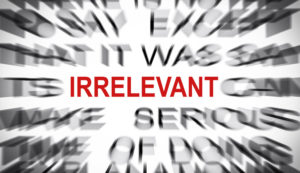 File this one under stupidity — or at least, not thinking straight…
File this one under stupidity — or at least, not thinking straight…
Facebook must have known this post would be good for a rant. Because they gave me one of those notifications. You know the one. So-and-so connection posted in so-and-so group.
Now, to be fair, the original post wasn’t stupid.
But it was asking about some general stupidity amongst salespeople and marketers.
It was asking about “sales close rate.”
Specifically, who in sales is currently closing 90% of their leads?
Basically, the original poster said that they’d seen others talking about close rates like this… And they didn’t believe ‘em.
Here’s what I say…
No matter what your close rate, that number is IRRELEVANT and a total BS statistic!
The same thing goes for conversion rates, the most commonly-tracked marketing metric.
Here’s the thing…
Close rate and conversion rate don’t tell you ANYTHING about the ultimate effectiveness of a salesperson or piece of sales-focused marketing.
Huh?
Let’s compare a couple examples.
Let’s say you’re a sales superstar. But you’re working in a boiler room call center, selling $12 magazine subscriptions. You can sell those all day long, and I don’t care who you are or what your close rate is, that doesn’t translate into real money.
Even if you close 100% of the people you talk to, and it takes 10 minutes per order…
You’re still only generating $72 per hour in total business!
Do that flawlessly, 40-hours-per-week, 50-weeks-per-year, and you’re still only generating $144,000 per year in business. Considering that your commission is likely only a small percentage of that, it’s NOTHING!
Or let’s say you’re okay at sales, but you have a great offer. Let’s say your job is to follow-up with qualified leads for kitchen remodels, at an average price of $30,000.
Your average time to follow up with each lead is 8 hours, and you only close 20% of them.
That means that once per week, you’re closing a $30,000 sale. 50 weeks per year, you’re doing $1.5 million in business.
See how suddenly sales closing rate doesn’t matter nearly as much?
Let’s try another couple examples. Let’s say you’re working side-by-side with another salesperson, selling the exact same widgets, at $1,000 each.
You sit and wait by the phone for people to call in and order. Your marketing does okay, and generates one of these calls every day. You do a great job, and you close 90% of them.
Doing the math, that’s 225 widgets sold every 50-week work year, and $225,000 in revenue.
But the other member of your sales team does outbound sales. They call 20 qualified prospects per day, make 5 pitches, and sell two. You could call this a sales close rate of 10% (based on the number of prospects called) or 40% (based on the pitches delivered). Either way, it’s much lower than your 90% close rate.
But every day, they’re selling two widgets, and you’re selling one. At the end of the year, they’ve sold 450, and you’ve sold 225. They’ve generated $450,000 in sales, to your $225,000. Even with a lower close rate.
There are many factors that go into close rate and conversion rate — and they have NOTHING to do with actual sales and profits!
— The colder the leads, the lower your close rate will be…
— The more you disqualify to only find the best buyers for your offer, the lower your close rate will be…
— The higher the price or other hurdle to purchase, the lower your close rate will be…
— The earlier in the buying cycle you speak with a lead, the lower your close rate will be…
Should I go on?
This isn’t just about sales skills. There’s so much more to it. In some markets, the best sales people know that they need to DISQUALIFY a large number of leads to make sure that only the best buyers are getting all the way to purchase.
For example, if you speak with a ton of leads for a copywriting, coaching, or consulting business, you may decide that only a small portion are a really great fit for your service.
If you close a higher percentage than whatever that number is, you’re going to be creating a fulfillment headache. Because then you’re dealing with clients that are not a good fit for you.
And sometimes a really high close or conversion rate just means you’re not aggressive enough going after leads that are more unaware of your product, service, or solution. And the only way you’re really going to scale is by reaching out further into the market, necessarily driving down your close or conversion rate.
But you still really want to track your close rate? Here’s why that’s GOOD…
Whether you’re talking close or conversion rate, I still think you should track it — and know what it is. Why?
NOT because it’s a relevant comparison metric between businesses.
Heck, it’s probably not even a relevant comparison metric between most sales people in most businesses — unless they’re tasked with exactly the same group of leads, trying to sell the exact same offer.
Rather, knowing your close rate, and tracking it through time, gives you self-measurement.
You can test and try new things. See how it impacts your close rate. Improve and optimize your pitch. See what that does for response.
Early on, you track it to calibrate a base line. Then, through time, you turn it into a game. You try to beat yourself, again and again. Knowing that will lead to other metrics that matter, like total revenue, profits, commissions, royalties, etc.
In that regard, it’s incredibly useful…
Yours for bigger breakthroughs,
Roy Furr



